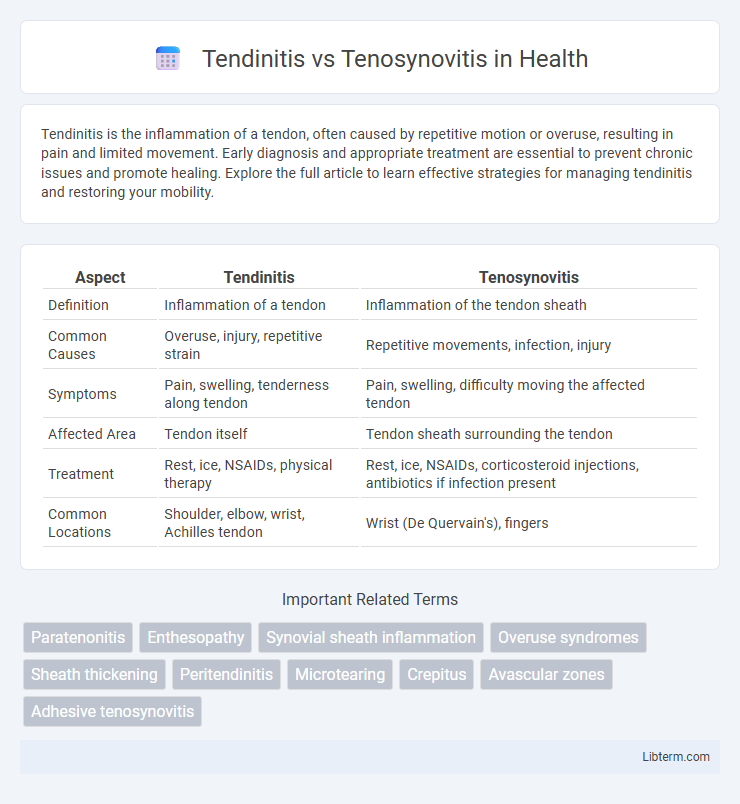Tendinitis is the inflammation of a tendon, often caused by repetitive motion or overuse, resulting in pain and limited movement. Early diagnosis and appropriate treatment are essential to prevent chronic issues and promote healing. Explore the full article to learn effective strategies for managing tendinitis and restoring your mobility.
Table of Comparison
| Aspect | Tendinitis | Tenosynovitis |
|---|---|---|
| Definition | Inflammation of a tendon | Inflammation of the tendon sheath |
| Common Causes | Overuse, injury, repetitive strain | Repetitive movements, infection, injury |
| Symptoms | Pain, swelling, tenderness along tendon | Pain, swelling, difficulty moving the affected tendon |
| Affected Area | Tendon itself | Tendon sheath surrounding the tendon |
| Treatment | Rest, ice, NSAIDs, physical therapy | Rest, ice, NSAIDs, corticosteroid injections, antibiotics if infection present |
| Common Locations | Shoulder, elbow, wrist, Achilles tendon | Wrist (De Quervain's), fingers |
Understanding Tendinitis and Tenosynovitis
Tendinitis is the inflammation or irritation of a tendon, typically caused by repetitive strain or injury, resulting in pain and restricted movement. Tenosynovitis involves inflammation of the synovial sheath surrounding a tendon, often leading to swelling, tenderness, and difficulty moving the affected joint. Differentiating between tendinitis and tenosynovitis is crucial for targeted treatment, as tendinitis primarily affects tendon fibers while tenosynovitis involves the tendon sheath's lining.
Key Differences Between Tendinitis and Tenosynovitis
Tendinitis involves inflammation of the tendon itself, whereas tenosynovitis affects the synovial sheath surrounding the tendon. Key differences include painful swelling localized to the tendon in tendinitis, compared to a more diffuse swelling and crepitus frequently observed in tenosynovitis. Diagnostic imaging such as ultrasound or MRI can help distinguish these conditions by highlighting tendon thickening in tendinitis and fluid accumulation in the tendon sheath indicative of tenosynovitis.
Causes and Risk Factors
Tendinitis is caused by repetitive strain or acute injury leading to inflammation of the tendon, often seen in athletes and manual laborers. Tenosynovitis involves inflammation of the synovial sheath surrounding a tendon, frequently resulting from repetitive movements, infection, or autoimmune disorders like rheumatoid arthritis. Risk factors for both conditions include overuse, aging, diabetes, and occupations involving repetitive wrist or hand motions.
Common Symptoms and Warning Signs
Tendinitis and tenosynovitis both involve inflammation but differ in affected tissues; tendinitis affects the tendon itself, while tenosynovitis impacts the synovial sheath surrounding the tendon. Common symptoms for both conditions include localized pain, swelling, and tenderness near the joint, often worsening with movement. Warning signs such as persistent stiffness, redness, and warmth around the affected area indicate the need for medical evaluation to prevent chronic complications or tendon rupture.
Diagnostic Methods and Tests
Diagnostic methods for tendinitis primarily involve physical examinations assessing pain, swelling, and tenderness near affected tendons, supported by imaging techniques like ultrasound and MRI to detect inflammation or tendon tears. Tenosynovitis diagnosis relies on clinical evaluation of joint swelling and pain along the tendon sheath, often confirmed through ultrasound imaging, which reveals fluid accumulation and synovial thickening within the tendon sheath. Laboratory tests, including blood markers for inflammation, may aid in distinguishing tenosynovitis caused by systemic conditions from isolated tendinitis cases.
Treatment Options for Tendinitis
Treatment options for tendinitis primarily involve rest, ice application, and nonsteroidal anti-inflammatory drugs (NSAIDs) to reduce pain and inflammation. Physical therapy exercises that improve flexibility and strengthen surrounding muscles support tendon healing. In severe cases, corticosteroid injections or platelet-rich plasma (PRP) therapy may be recommended to accelerate recovery.
Management Strategies for Tenosynovitis
Management strategies for tenosynovitis focus on reducing inflammation and preventing tendon sheath irritation through rest, immobilization with splints, and nonsteroidal anti-inflammatory drugs (NSAIDs). Physical therapy, including gentle range-of-motion exercises, helps restore mobility and strength without exacerbating symptoms. In refractory cases, corticosteroid injections or surgical intervention, such as tenosynovectomy, may be necessary to alleviate persistent inflammation and restore function.
Prevention Tips and Lifestyle Modifications
Preventing tendinitis and tenosynovitis involves regular stretching and strengthening exercises to maintain tendon flexibility and reduce strain. Incorporating ergonomic tools and taking frequent breaks during repetitive activities minimize stress on tendons and tendon sheaths. Maintaining a healthy weight and avoiding sudden increases in activity intensity also support tendon health and reduce inflammation risk.
Complications and When to See a Doctor
Tendinitis and tenosynovitis can lead to complications such as chronic pain, tendon rupture, and decreased joint mobility if left untreated. Tenosynovitis, involving inflammation of the tendon sheath, may cause swelling and fluid accumulation, increasing the risk of infection and permanent tendon damage. Seek medical attention if symptoms include persistent pain, swelling, restricted movement, or signs of infection like redness and warmth around the affected area.
Long-Term Outlook and Recovery
Tendinitis typically involves inflammation of the tendon itself, often resulting in localized pain and stiffness, with recovery ranging from a few weeks to several months depending on severity and treatment adherence. Tenosynovitis affects the tendon sheath and may lead to prolonged swelling and restricted movement, often requiring more extended physical therapy or, in chronic cases, surgical intervention for full recovery. Long-term outlook for both conditions improves significantly with early diagnosis, consistent rehabilitation, and modification of aggravating activities to prevent recurrence.
Tendinitis Infographic

 libterm.com
libterm.com